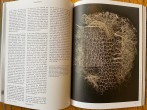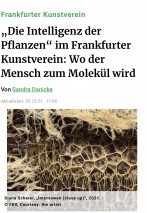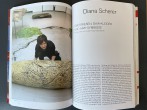

#1
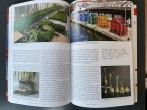

#2
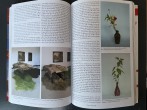

#3
About Giants, Gaia Dresses and Anti-Symbiosis
A conversation by Herbert Kopp-Oberstebrink
The art of Diana Scherer (*1971) makes the invisible visible and in the process reverses the grown orders of above and below. For example, she shows roots resting on a bale of earth at the top, while blades of grass lie at the bottom. Initially, she is intensively concerned with the material aspects of art. Over the last ten years, her preferred materials have been various types of grass, mostly oats, maize or wheat, earth, water and plastics. With the help of science, Scherer researches the growth and growing conditions of grasses and cultivates them in greenhouses. Cultivation – in its old sense of cultivation and care – does not mean allowing, but rather disciplining and shaping. Scherer also demonstrates this and thus takes us back to the beginning of human culture and civilisation. But what has grown naturally and cultivated is only one domain of her art. She goes one step further and reminds us that our dissecting-curious gaze presupposes a rupture, a damage, be it of the grown form (grass field), be it of the cultural form (vases) – a killing of the natural. Scherer’s artistic practice follows an aesthetic of interaction, and this in several respects: the interaction of natural growth processes and human interventions, of natural and culturally shaped materials, of natural forms and art forms, of art and scientific material research, botanical expertise, horticultural practice.
https://www.kunstforum.de/artikel/diana-scherer/
On Roots and Men:
Interwoven Narratives in the Age of Hybrid Realities
Herbert Kopp-Oberstebrink and Judith Elisabeth Weiss
When we view an artwork like Interwoven in an exhibition, we find ourselves amazed at its rampant, exuberant materiality in the shape of earth, grass and roots. The arrangement fills the entire space – there is no contending that. But its boundaries are partially blurred and its future uncertain. Will someone be watering this green entity throughout the presentation period? Cactus fans apart — every person who has indoor plants knows what fate its darling faces without life-sustaining water. We can only find the answer to our question if we visit the exhibition again at a later point in time. And we ask, too, is what we see simply only what we see? The renitence of the artistic material makes us think about its symbolic meaning, meaning that can possibly be translated into the material itself and enables us to understand the piece. With questions such as these, we find ourselves at the centre of the aesthetic interplay between the finished work and the beholder. Thus, the relationship between the materiality, form and metaphorical meaning of the artwork – and the specific temporal and processual quality inscribed into this artist’s work – are key aspects of the following considerations. It is apparent again that we need art and its powers of distillation to absorb ‘plants in the architecture of our imagination’ and in this way to come to an appropriate understanding of ourselves as part of nature.
Number, Proportion, Harmony – the Artificial Order of Nature
At the beginning there was seed, earth, water and light. At first glance, the genesis of many of Diana Scherer’s artworks seems to begin in this way. Growth follows, roots and the interlacing thereof, the budding of green tips, the development of carpets of grass, oat or wheat, all tended by the caring hands of the gardener in the harmonic interplay between nature and agricultural practices.
This light-filled narrative, however, sketches only one dimension of an artwork that in its multi-layered intricacy is difficult to define. Generated in a long-term process, the current discourses and patterns of interpretation obviously relevant to these artworks do not do them justice. Instead, they unfold new perspectives in individual moments to the gaze, perspectives that dissolve, again and again, with each new gratification in precipitate insights dissolving into new queries. This naturally poses a great challenge to the beholder.
Viewed from the perspective of the generation of individual works, the results are clear – the world of computers and artificial materials precedes the phases of germination, growth and the production of roots. Diana Scherer drafts structures with a computer for templates with geometrically ordered patterns. These she inserts into earth and mixes in the seed. The subsequent growth of the plants literally follows an artificially generated order, an underground building plan for the world of roots, greenery and their codes.
What in this case seems generated by means of the interplay between an artistic mastermind and the natural sciences, mathematics and technology, can be comprehended as the aesthetic model of an old concept based on a line of tradition from Platonism to Neoplatonism. Already in the Pythagorean tradition we find the notion of an order of the world called ‘cosmos’. Timaeus, a late dialogue of Plato’s, takes up the idea that the universe is based on a specific order. The maker of the world, the demiurge, created a cosmos that is ‘visible and tangible and having a body.’ Proportion connects the separate parts. In this conception, numbers become the matrix of everything found in the natural world – as proportion is nothing less than numerical ratios.
Mathematization and geometrization supply the key to the fundamental operations in the world and its material elements. In terms of intellectual history, this fundamental Platonic principle – in various, occasionally wholly esoteric variations – comprises the key to the order of the universe. Since the early seventeenth century at the latest, John Kepler added the idea of harmony – underscoring a further aspect of a mathematized cosmos. As Ernst Cassirer noted in regard to Kepler: ‘Harmony…refers to the idea of the world as an ordered cosmos that is organized according to geometrical laws.’ Kepler’s idea of all nature being intrinsically a harmonious fabric was the first step in the comprehensive aestheticization of nature.
The aesthetic of pieces such as Interwoven and its ‘beautiful, alien patterns’ – as Wired, a computer journal, lauded Schwerer’s artworks – may indeed lie in the aesthetic and harmony of this kind of mathematized order. Diana Scherer knows of this intellectual tradition; she is part of it with her work and takes it another step forward in terms of art. A specific difference can be discerned in the initial steps in making this artwork, however. Although a computer program is behind the operational procedures used to make the form templates for root growth, the material making up the data that was fed into the computer beforehand was generated under natural conditions (honeycombs, spider nets, cell structures) as well culturally (grids, tire tracks and bubble plastic). In other words, when Diana Scherer creates her worlds, the beginning is marked by hybridity with culturally and naturally shaped materials and artistic design.
Collaboration and Symbiosis? Working with Models and in Opposition to Models
If we follow the further development of the artwork, the overarching theme, Diana Scherer’s intellectual focus, becomes obvious in all its complexity. After the initial phase in which the artist prepares the work comes what she sees as its key aspect – the growth of the plants. The artistic practices during this phase correspond with the work of a gardener. Planting, tending and caring are, in this instance, by no means subordinate practices and instead symbolically represent fostering nature in our dealings with it.
The roots create a carpet of grass in the underground template at the growth stage; the roots literally adapt their pattern of growth to the template and adopt its patterns and structure almost to perfection. The templates acquire a function that can be compared to moulds for root materials. Artistic processes and horticultural practices merge in the time-consuming genesis of the material of the artwork; a line cannot be drawn between them in this phase. The prerequisite for both is artistic research guided by science – for the investigation of training the roots in such a way is based on Scherer’s collaboration with scientists and is part of her artistic research. Science has already established the fact that mycelles can take on all sorts of forms. However, the scientists working together with her on the project were sceptical about the ability of the roots of plants to do the same, whether they too could be shaped artificially to grow into certain shapes.
Multiple cultural forms of knowledge and practices are thus employed to produce a kind of artificially created natural environment. The beholder is under the impression of seeing an entity that has been cultivated along these lines as organic. The current intellectual discourse actually sees such practices as paradigms of cooperation or collaboration with nature. Nature cooperates with us, and we cooperate with nature. Diana Scherer’s artworks are viewed within this paradigm, not least by the artist herself. The implications thereof are, admittedly, largely of an ethical nature and linked to an ecology of human behaviour toward an idea of nature in which humankind is part of it. In the meantime, ample scientific evidence has proven the existence of root systems interwoven with mycelle colonies in forests. The non-hierarchical, non-competitive exchange with which trees communicate and cooperate with one another has gained a lot of traction in an anti-apocalyptical discourse. Such a model hinges on the formation of a counter-narrative to Darwinism, which has reigned alone and supreme for over 150 years under the banner of struggle and competition – and has been constantly reinterpreted and frequently misunderstood. The essence of this counter-narrative can be described as – for the survival of the fittest – strategies of collaboration, cooperation, interaction and symbiosis being of fundamental importance. The inherently ethical stimulus behind this model is as obvious as the accompanying anthropomorphization of processes in plants and vegetation. The good intentions behind it are obvious. Perhaps we could argue from a sceptical angle and say that such a model is merely one of the most appealing narratives and myths that give us hope in the hopelessness of our current situation. The natural sciences have, in the meantime, voiced their doubts about this hypothesis, which is linked to the catching term Wood Wide Web.
Diana Scherer’s art obviously sympathizes with the model of the Wood Wide Web. But her work and the artistic processes she applies also raise the critical question and, in this way, reveal the fundamental ambivalence in our dealings with nature: To what extent does speaking of cooperation with nature make any sense and is it in any way consistently logical? Or is it not rather the case that conditions are artistically and culturally utilized that otherwise belong to self-sufficient natural processes? After all, the idea of working together, which is currently predominant in intellectual debate, veils an obvious asymmetry. It would at least have to also include the option of refusing to do the same – if it were the sensible thing to do. If we look at the individual moments in time in the concrete artistic processes behind Scherer’s artworks, we can see that they point out this asymmetry and even accentuate it.
A key component of Scherer’s conception is plumbing ‘how humans can manipulate nature for our own use.’ Thematically addressing humankind’s desire to rule over nature – indeed, the necessity thereof in order to check the undesirable proliferation of vegetation – is not only the point in Scherer’s large-scale project Interwoven (2016 and ongoing): ‘The roots that I domesticate, I want them to follow me’ The authoritative gesture of empowerment inherent in growing and literally training the roots must be scrutinized in more detail, as in this we find a fundamental stimulus in the pursuit of the appropriate form.
Interwoven Narratives with Blossfeldt – Hybrid Materiality and Pictorial Design
The Grown Root Textiles (2022) are examples of how the cultural techniques of producing textiles are related to natural and independent growth. The textiles are hybrids that have grown naturally and, at the same time, have been fabricated culturally. The result is an inexhaustible myriad of forms that provides insight into how the artist designs and utilizes the constructive and ornamental possibilities for creating patterns. Exercises in form to achieve the effects of symmetry and its disruption, exercises in drawing the finest hairs on roots, in cohesion in matting – the austere surfaces of the photographic Exercises (2016) are the pendant to the haptic, root-based matting textiles. The photographs call to memory an important legacy from the great mass of plant photography up to the present; they cite Karl Blossfeldt’s iconic photographs of plants, images that are deeply engraved in cultural memory. In all likelihood the most famous Neue Sachlichkeit photographer, Blossfeldt left a monument to common garden weeds in over 6,000 photographs taken between 1895 and 1932, the year he died. These he called ‘records of plants’ and ‘image documents’.
He was not interested in finding the evidence of things that were optically invisible but sought instead to ‘make the beholder see the visible’. Creating images in order to make things visible has the goal of drawing our attention to things, of making us receptive to things that, while visually present, are on the peripheries of our field of perception or are inconspicuous. The models for the essence of ‘pure form’ slumber within this realm of the unnoticed – and it is the job of art and the crafts to make use of this. To find the essence of form, Blossfeldt intervened by means of arrangement, design and manipulation. He cut away the parts of the plant that did not fit in with the aesthetic form with a dissecting knife, he unfurled buds, ordered parts of plants in stringent symmetrical patterns and fixed them into place with plastic modelling material. [Fig. 5] He did all this to make hidden details and the minutiae of the manifestations of plant growth, its tectonic or ornamental qualities visible. The result is an endless reservoir of prototypes of vegetable motion, be it linear, wavy, fluid or interwoven, be it scroll-like, entwined or ramified – as well as vegetable patterns of a tectonic, structural and geometrical nature.
One of the key differences between Scherer’s and Blossfeldt’s works lies in the indexical foundations of these images. What Blossfeldt resolutely eliminated – the roots of the weeds and herbs – are equally important in Scherer’s eyes. She generates form out of the hidden terrain of the earth – and also from zones that escape our visual perception, those for which humankind needs technical support to see them. An example for this would be the microscopic photographs of the cell tissue of plants that has undergone a transformation owing to climate change. The artist has integrated this in her matrix. The way she links naturally existing patterns and structures with signs and traces left by humans – such as the structure of a car tire in mud or burnt wood – transposes ‘pure forms’ or archetypes into hybrid forms. Scherer gives Blossfeldt’s oeuvre a further twist by burying her pattern templates in earth so that the grasses with their root growth shape a three-dimensional image. In this state, the artistic dictate of forma and the vegetable process toward eidos become one. The artist makes the image, which is woven underground, visible by the final, drastic step of uprooting, cutting through and fragmentization.
Killing – On the Cultural Performance of Destruction, Uprooting, Annihilation
Diana Scherer sets in motion a kind of dialectic of cultural forms and cultural behaviour in her art in the interplay of collaboration with nature and the opposing mastery over nature. She not only spreads out the lush verdant green of caring horticultural work for us to witness – but also the opposite – destroying what she tended beforehand. The carpets of grass devotedly grown by the gardener therefore hardly differ, in terms of plant physiology, from a meadow that grows naturally. Two spheres can be differentiated from one another phenomenally – one of latency and one of manifestation. The underground sphere comprises the network of roots, the sphere that is above-ground displays the abundant growth and lush verdancy. The next step of Scherer’s artistic work draws our attention to the hidden world of the roots. At the end of the growing phase follows what the artist terms ‘the harvest’, again resorting to agricultural metaphors. A radical act lies behind the harmless expression, a procedure that literally zeroes in on the roots of things – the roots are cut off and then the carpet of root systems is lifted out of the ground. The harvest of the roots presents a drastic image of the inversion of cultural history, an image that has also political implications. The domestication of plants and the associated practice of harvesting represent a key turn in the history of humankind since it began to settle the land in the neolithic revolution, literally establishing roots. In face of the impact of life depending increasingly on technology, the ruthless exploitation of the Earth as the other side of the coin of harvesting and the increase in human migration make Scherer’s artworks appear as if they were presenting the other side to the history of cultivation.
Artistic manipulation of plants and roots for the purpose also of creating form was already manifest in the early series of works, Nurture Studies (2012). [Fig. 7] The various flowerpots and vases – in which plants and roots grow – comprise the controlling force that hinders the roots in growing freely. Cutting the roots with a knife is on par with hitting the pot or vase with a hammer to reveal the root systems. The smashed container, too, is disconcerting for visual conventions within cultural history and Western iconography, which have generated all sorts of potted plants that, in general, symbolize cultivated nature. The roots hold the naked and vulnerable form together. Filmed by a camera, the plant acquires a sculptural appearance. The sculptural quality, however, is fragile, threatening to decay and crumble away. Culture is a permanently threatened field. To assert itself, it produces set forms, traditions, rites and customs, set notions of above and below. Sometimes this leads to cultural forms that appear ossified, over-finished, disciplined and correct. But, at the same time, it harbours the seed of dissolution, of destruction for the restraint it generates. Regardless of the fundamental difference between vegetable and organic life, we cannot deny that the so-called harvest – or cutting through the roots – means the decay, eventual demise and death of the plant. Roots and verdure gradually dry out and change the colourful opulence into a monochrome homogeneity. It is part of the concept of the installations of the Interwoven series that the different exhibition organizers do not interfere with the processes of decay, such as watering. The consequences are that curators ask: ‘What can we do so that the piece survives?’ The stance of the artist seems logical from the conceptual angle, who answers: ‘No, you can’t do anything, and that is the way I want it.’ Scherer’s art also triggers aggressive reactions among her audience. They are moved out of sympathy for plant life ebbing away by an act of a violence that slowly manifests itself.Reactions of this kind demonstrate a recent and newly described phenomenon – mourning dying nature. What psychology calls ecological or climate grief is the term describing feelings of pain and loss about non-human entities such as eco-systems, fauna and flora, cherished places, forests and water. The symptom of ecological grief expands the image of an ailing nature as perceived by people who wish to protect or heal nature. The fear of irreversible changes or so-called tipping points is great and can no longer counteracted by means of the construction of rectifying symptoms by care.
What we can call the tipping point from a processual angle in Scherer’s artworks is setting the demise of the plant in motion. This points out the ambivalence in our treatment of the natural environment and plants. Pieces such as Interwoven address a fundamental dilemma – the schizophrenia in how humankind deals with nature and naturally growing plant life. They manage the feat of making the beholder physically feel this dilemma in the experience of ecological grief. Mindfulness toward plant life cannot remedy this bipolarity. Rather, an inescapable and characteristic feature of our culturally oriented care of nature and natural things as objects is that we tend and nurture them. By keeping this in mind, we are able to recognize that the artist is against submitting to a convenient, alternative symbiotic model of thought, that for her they are just another kind of indolence.
In whatever way we interpret this both natural and cultural reality today, we can always only be ambivalent in our relationship to it – on the one hand caring and tending, on the other destroying and killing. The harvest as the gain of the yield and net profits from our agricultural and horticultural relationship to nature means, from an aesthetic perspective, killing nature as an artistic act. The artworks of the Interwoven series, however, go a step further. Interwoven roots reveal themselves as the hidden reality of a ‘nature-culture’ – which can no longer be extricated from human intervention, or more precisely, never was. Interwoven takes roots as a comprehensive and redeeming model of thought both literally and figuratively. Compared to what we might term ‘green’ art, which is based on natural and organological growth as well as on the artistic symbiosis with natural growth, the series accentuates, in a single gesture of radical aesthetic and artistic decision, the act of self-empowerment that is inherent to each and every artistic activity. Essentially, the symbolic form art can never deviate from this role.
Taking a look at art history will ultimately verify this. In it we find a long tradition of destroying nature in order to make art. Part of this tradition are moulds made directly from animals and plants in early modern times. In the process of doing this the natural object was burned to fine ashes. Works of art created in this way are not evidence of being part of a dystopian design that laments the loss of nature. Instead, the creative process draws on the dialectics of the death of the living creature or object being moulded in order to produce a new form for art. We can also view the prints by James Audubon as belonging in this category. According to information we have from this illustrator, he shot up to one hundred birds during the day. These he put into position using wire framework in order to draw his magnificent pictures, in which he imbued, so to speak, the birds with new life. He saw his illustrations as ‘ornithological biographies’ and ‘stories of the lives of birds’. The cultural practice of killing original nature in order to produce a ‘second nature’ in art is understood, since the advent of modernism, ultimately as a self-referential critique of the conditions of art. Nature is and always has been the focus of interest for art.
Making the Invisible Visible – and vice versa
Where can we position Diana Scherer’s art in this tradition? What is the artistic strategy behind cutting through roots and letting areas of green growth die off? In literature and the media, references to the ‘secret’ or ‘hidden’ are part of the topos of many publications on the Wood Wide Web and root networks. The topos in titles such as the Secret Lives of Trees is omnipresent in the meantime. The artistic process that Diana Scherer applies can be understood as a response to mystifying metaphors of this kind. Interwoven – playing on notions such as aesthetic beauty and epistemic curiosity – brings life to the surface what is necessarily hidden from view or is underground, transposes the latent into the manifest and vice versa.
Taking such ideas as her point of departure, Scherer’s artworks participate in the scientific initiative of the visualization and objectification of natural processes. Numerous atlases on roots have already documented the life of plants in the earth. In them the visualization practices go back to the first scientific drawings of root systems in the nineteenth century. The life of trees that takes place in the dark, so to speak, has been shifted into the glaring light of scientific observation and reveals the strange beauty of vegetation networks. The beauty of the root systems in Diana Scherer’s art is, however, of a broken kind. Her work generates a dialectic interplay between showing and hiding and from a philosophical perspective, so to speak, transgresses her participation in scientific thought – for the price she pays in showing the root system is hiding the greenery.
Inversion disrupts the accustomed geometry of space and its fixed hierarchy. In this way, the works of the artist share common ground with a tradition of thought that goes back to the reception of Plato in ancient Greek times and is still very much alive today. It delivers an arsenal of ideas for counter-narratives. In reply to Empedocles’ then generally accepted assumption that the ‘growth in plants is to be explained [by] the downward rooting by the natural tendency of earth to travel downwards,’ Aristotle states that ‘up and down are not for all things what they are for the whole Cosmos: if we are to distinguish and identify organs according to their functions, the roots of plants are analogous to the head in animals.’ Darwin’s root-brain hypothesis can be seen as one of the late offshoots of this debate, and with it the long discourse on the intelligence of plants since the nineteenth century. The Platonic origins of this tradition corroborate the analogy of roots and head. An anthropological bent inverted above and below – and the roots lead to the heavens: ‘We are a plant not of an earthly but of a heavenly growth…for the divine power suspended the head and root of us from that place where the generation of the soul first began.’
Cosmos, Earth or Gaia?
Plato’s anthropological conception of the root metaphor might well have found a late response among the Romantics. The scholar and philosopher Franz Joseph Molitor concluded that ‘letters have their roots above’ in his studies of the Jewish and Christian Kabbalah. That is, it is not about humans, but about the Earth, the world and the cosmos. He meant of course with ‘letters’ the phrase introducing the Christian creation myth ‘In the Beginning was the Word’ (John1:1). Language and letters are the medium of the creation of the world, which would not have taken place without the networks and interconnection of root systems. This aspect has often been overlooked in the past. However, the adoption of the root metaphor does not necessarily imply that theology was involved. ‘Once blasphemy against God was the greatest blasphemy; but God died, and therewith also those blasphemers. To blaspheme the earth is now the dreadfulest sin, and to rate the heart of the unknowable higher than the meaning of the earth!’ – wrote the trail blazer and prophetic critic of postmodern thought, Friedrich Nietzsche, who was dedicated to this sin to the extent of self-annihilation. Diana Scherer’s speech act of world creation is ‘The roots that I domesticate must do as I tell them.’ If you pack a plant by the roots, you can be sure that this gesture is hard to be outdone and generates, as did Diana Scherer, an artwork like Hyper Rhizome (2019/2020). Although you might read an artwork like Interwoven as a kind of textual fabric, the objection that Scherer is raising in her works is manifest at another, more fundamental spot. A common thread running throughout Nietzsche to Bruno Latour can be found in the bonds with the earth and the concept of the terrestrial, seeking to escape the mess of destructive exploitation and arrogance of humankind.
This is the perspective behind the large and ambitious project Interwoven. The series can be ultimately understood as a grand cosmological metaphor in its individual moments of a processuality that reaches far back in time and spans artistic-demiurgic creation through to the decay of the created. The material draws attention especially to the earth used and can translate straight out as the symbolic meaning of the pieces. In such cases of ‘iconology of the material’, the artwork resounds from the idea to the material and from the material to the idea. The constant new experimentation with inversion, the continuous oscillation, utilizes the entire scope of our interventions in the world – they are abstract, concrete, spiritual, austere, scientific, poetic, formal and so on.
What remains in the end? Destruction or salvation? Change or inversion? To conclude we present Gaia, the personification of Earth, who has all roots hidden within her. Or rather, we present her cloak – the Gaia-Kleid or Gaia Dress. Diana Scherer hung some of these dresses on the trees in the 2022 exhibition in the forest of Oranjewoud. These sculptures are made in a gigantic size. In order for them to fit, we would have to be larger than human – but also more corporeal than the phantoms of the past. In the end Gaia will still be there, that is for sure. What is less certain, is whether she will be there with or without humankind.
(Translated by Christina Oberstebrink)


#1
Film about exhibition Farming Textiles 2023 -2024 Museum Kranenburgh
Avro Tros Kunst. Nu te zien!
https://npo.nl/start/serie/nu-te-zien/seizoen-8/nu-te-zien_49/afspelen
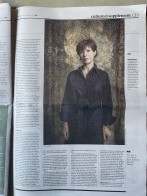

#1
Cultureel Supplement NRC
Lucette Ter Borg about the exhibition Farming Textiles in Museum Kranenburgh.
Dutch Television Avro Tros Kunst. Nu te zien!
https://npo.nl/start/serie/nu-te-zien/seizoen-8/nu-te-zien_49/afspelen
Volkskrant by Janna Reinsma *****
Trouw by Joke de Wolf
Radio
Nooit Meer Slapen
Springvossen
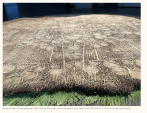

#1
Growing Sculptures: Interview with Diana Scherer
by Anna Roos van Wijngaarden
One of the pioneers in biotech art is Diana Scherer, a German researcher and sculptor who lived in Amsterdam for over 20 years. At the core of her botanical installations, textiles and photography lies a great admiration for and curiosity about what neurobiologists call “the brain of plants.” The artist studies plants and root systems so as to control their “natural” growth processes. In her studio she creates artificial biotopes to grow her root art using soil, seeds, light and subterranean templates from both natural and man-made patterns. The roots follow these patterns and from there on, the work grows itself.
Her latest commission for the 23rd Biennale of Sydney, ‘Entanglement’ (2022), explores xylem vessels, the critical tissue responsible for transportation of water through plants. We talked to Scherer about her slow “collaboration with nature” and how it intersects with science, ecology, and sculpture.
https://www.berlinartlink.com/2022/08/29/growing-sculptures-interview-with-diana-scherer/


